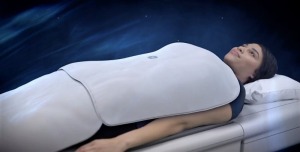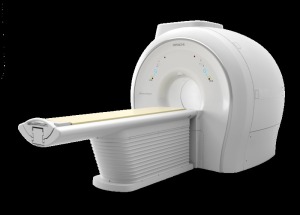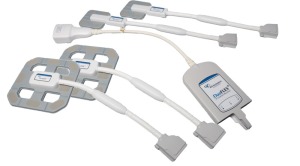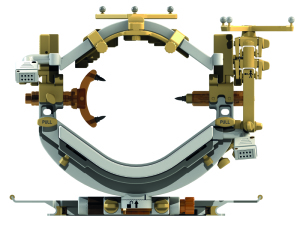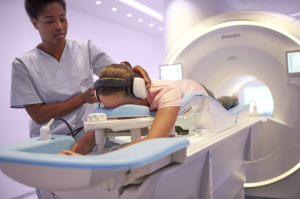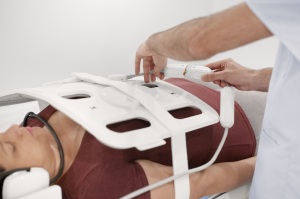Newest MR scanners and coils are faster, lighter and tailored to customer and patient needs
September 18, 2018
by Lisa Chamoff, Contributing Reporter
The trends in the MR space continue to center around increasing the speed of exams while maintaining image quality and ensuring patients are comfortable.
Manufacturers have developed and released new MR scanners and coils with those tenets of value-based care in mind. Scanners are getting faster and coils are becoming lighter, while accommodating patients of all sizes.
A few of the releases and planned releases are carrying MR into the future, with the FDA approving Siemens Healthineers’ 7T scanner for clinical use and Philips developing a magnet that requires only 7 liters of helium.
Here’s our look at the newest MR products that have been released over the last year.
Canon Medical Systems
At last year’s RSNA, Canon Medical Systems released an upgraded version of its Vantage Galan 3T with what the company calls the XGO Edition.
The system has a higher gradient amplitude specification that increases the signal-to-noise ratio, including about 30 percent in the brain.
“In MR, signal-to-noise ratio is currency,” said Jon Furuyama, senior manager of market development for MR at Canon.
The system includes what Furuyama called multiband SPEEDER technology.
“A conventional MR gets each slice one at a time,” Furuyama said. “This technology allows you to acquire multiple slices at the same time, effectively cutting the scan time in half.”
The technology is especially useful for high-end neurological studies looking at connectivity in the brain, while on the clinical side the exams are used for surgical planning.
GE Healthcare
GE Healthcare continues to market its SIGNA Premier, a 3T wide bore scanner that received FDA clearance in August 2017 and that comes with a SuperG gradient coil that the company says delivers high-quality images while accommodating larger patients.
GE’s adaptive imaging receive (AIR) Coil suite, developed with highly flexible and lightweight material — 66 percent lighter weight than traditional coils with 50 percent reduced power consumption, according to the company — are designed for patient comfort.
“The AIR coil itself uses brand new technology that hasn’t been used in coils in the past,” said Eric Stahre, president and CEO of GE Healthcare MRI. “It conforms to the body of each patient and it’s very lightweight for technologists. They like the idea of positioning the coil on a patient like a blanket instead of body armor.”
Stahre said the higher density coil elements also provide the opportunity to acquire images faster. The company is also building the intelligence into the scanner so the technologist doesn’t have to worry about optimizing the scan for the coils.
“The tech positions the patient on the table, lays the AIR coil on top of the patient, and selects the position of the anatomy to be scanned at the side of the table,” Stahre said. “As the patient moves into the scanner, coil locations are automatically detected by the system, which uses that information to optimize the coil element combinations, to enhance parallel imaging speed and image quality, over the prescribed field of view.”
The technologist can also turn various coil elements on and off.
The technology is available in a 48-channel head coil, a 30-channel anterior array providing 65 centimeters of coverage, and a 60-channel posterior array providing 110 centimeters of coverage.
Hitachi
Hitachi recently released its Echelon Smart 1.5T system, which is sold in Europe, Asia and other parts of the world, where there is a larger market for systems with a 60-centimeter bore.
“It has the same clinical capabilities as wider bore systems, but there’s just not a huge market for that in the U.S.,” said Jason Miller, director of the MR product line for Hitachi.
A little over a year ago, the company released a high-element body coil for its Echelon Oval 1.5T scanner, which consists of two pieces that latch together. Also new to the market are dedicated foot and ankle coils for Hitachi’s Oasis 1.2T open MR scanner.
MR Instruments
MR Instruments recently released the second generation of its DuoFLEX Coil Suite, which first came out in 2015, which features 12” longer cables and an added 60 degrees of rotation to reach all areas of the anatomy.
“Now DuoFLEX has multiple points in the cables that rotate slightly,” said Thomas Rheineck, the chief executive officer of MR Instruments. “This rotation maximizes anatomical positioning for optimal imaging”.
The coils are third-party-approved by GE Healthcare and, new this year, Siemens Healthineers for most of their 1.5T and 3T MR scanners.
“Customers want to only plug in and use coils that are supported by the MR OEMs,” Rheineck said. “This allows clients whose scanners are older to improve their image quality. If they’re newer systems, it expands their coil portfolio for broader based imaging applications.”
The DuoFLEX coils are a good supplement for OEM coils.
“If you have a Siemens head coil instead of a head/neck coil, for example, you can put two DuoFLEX 10-centimeter paddles anterior to the neck and image the cervical spine along with the brain,” Rheineck said.
The DuoFLEX coils are also compatible with older MRs that Rheineck said did not have good flex coils. And having two paddles of various sizes, a unique geometry, allows clinicians to scan any size patient.
“DuoFLEX can scan 100 percent of patients who walk in the door,” Rheineck said. “No one is turned away.”
Noras MRI Products
This past spring, Noras released a combination of head holder and coil for intraoperative MR imaging during neurosurgery. Called Lucy, the head holder, made with radiotranslucent material with three fixation points instead of the usual seven, can also be used without the coils for intraoperative X-ray and CT scans.
Manuel Noras, the company’s chief executive officer, said the product can be used with Siemens’ MAGNETOM Aera and Skyra and that Noras was asked by Siemens to develop an established head holder.
Noras said that in developing the Lucy, it paid attention to the various clinicians who would be using it and made sure to tailor the workflow.
“It is important to see the workflow before using the coil and after using the coil,” Noras said. “Oftentimes, many specialties mix together – neurosurgeons, neuroradiologists, nurses, OR staff. It has interfaces with navigation systems, OR tables and scanners. It’s fairly complex. You can’t compare it with a standard elbow coil.”
The company also recently released its BI 7 seven-channel breast biopsy coil, which was developed together with Siemens for use on the company’s MAGNETOM Vida and Sola scanners. The breast coil is sold through the MR division of Siemens’ OEM channel.
“We developed this coil exclusively for Siemens as a successor product for our BI 4 breast biopsy coil,” explained Noras.
Philips Healthcare
Philips has had two scanner releases in the last year.
At last year’s RSNA, the company debuted the MR Prodiva 1.5T, which is what Arjen Radder, global business leader for MR at Philips, calls a “workhorse” scanner with a 60-centimeter bore. With the release of the Prodiva, Philips also introduced a set of ultralight coils called Breeze Workflow.
In June, Philips received FDA clearance for its Ingenia Elition 3T scanner, which features the company’s Compressed SENSE acceleration technology, which Radder said can reduce the average scan time by about 50 percent while maintaining image quality.
“We try to understand customer needs,” Radder said.
The Elition comes with advanced MR technology, including VitalEye, an optical technology that sits in the bore and is able to track respiratory movement and perform motion correction, while a technology called VitalScreen guides patient setup.
Philips has also been promoting its newly developed BlueSeal Magnet, which Radder said only requires seven liters of helium, as opposed to the 1,500 liters of helium that most MR scanners utilize.
The company began promoting the BlueSeal Magnet in June at the ISMRM annual meeting in Paris.
Radder said the BlueSeal magnet will be linked to a new 1.5T scanner that is undergoing FDA clearance. Because of the lower helium use, it will be able to be installed in more locations in a typical facility. If there is a magnet quench, the amount of downtime will be significantly reduced.
“We believe that customers that have needs around productivity and speed will appreciate our solutions, while others have concerns about construction or room size that we also address,” Radder said. “We are confident that these are breakthrough technologies and we will have a large audience interested.”
ScanMed
This fall, ScanMed, an MR coil manufacturer, is releasing upgrades to its Pediatric Blanket Coil, released in 2012, and its PROCURE prostate pelvic coil, which came out in 2013.
The company is taking advantage of newer lightweight polymers to create more flexible and comfortable coils, said Natalie Hussey, ScanMed’s marketing manager.
“A lot of that technology has moved forward since we originally developed those coils,” Hussey said. “We’re taking what are already great, effective products and improving them from a patient’s perspective. We’ve got excellent prototypes already. They really are dramatically lighter.”
The coils are compatible with GE, Siemens and Philips MR scanners.
In the future, ScanMed is looking to move further into contract engineering, partnering with other companies to manufacture MR products, with an eye toward using MR coils for treatment rather than diagnostics. Such uses include MR-guided biopsy and MR for hyperthermia therapy for cancer treatment.
Siemens Healthineers
Last fall, Siemens Healthineers became the first company to have a 7T MR system cleared for diagnostic imaging.
The MAGNETOM Terra is designed with an ultra-high-field strength magnet to visualize greater anatomical detail, allowing for advanced applications in diagnostic neurological and musculoskeletal exams. The system is also used by researchers who can leverage a “research mode” for investigational (not 510(k)-cleared) scanning of any body part.
“The higher resolution offers radiologists and physicians the potential to see greater detail in anatomy and greater detail in pathology,” said David Carpenter, the manager of emerging technologies for MR at Siemens Healthineers North America.
For example, the company sees an opportunity to detect the anatomic source of seizures for a third of epilepsy patients that don’t respond to drugs, allowing for surgical interventions. On the flip side, the scanner may also help avoid noninvasive interventions through more detailed imaging of knee cartilage and tissue.
The first MAGNETOM Terra was installed in October at the Mayo Clinic and the first patient was scanned clinically in December.
While facilities may not be able to invest right away in the MAGNETOM Terra, Carpenter noted that a lot of the work on the technology of the system has migrated into the company’s 1.5T and 3T products.
“Historically, the acquisition of extremely high-resolution 7T images could take a long time,” Carpenter said. “However, key technologies have been developed to acquire data more rapidly. Much of this is now brought to other 1.5T and 3T scanners. The whole Siemens Healthineers MR portfolio is benefiting from the ongoing 7T development.”
The scanner has a zero-helium boil-off magnet, which the company said is 50 percent lighter than any other 7T magnet and can easily be installed even on the upper floors of a facility.
Carpenter notes that the MAGNETOM Terra is a draw from a marketing perspective for facilities large or small.
“Patients are now are asking about the system,” Carpenter said. “It’s really a beacon that can draw academic talent and patients from around the world.”
Siemens Healthineers has also been developing new coils for its 3T MR systems. The company recently released the Contour 24, a flexible24-element abdominal coil for use with the MAGNETOM Skyra.
“Our coils have always been ultra-light compared to all of our competitors – oftentimes 50 percent lighter,” said Wesley Gilson, MR product manager at Siemens Healthineers North America.
Last year, the FDA cleared the company’s MAGNETOM Vida 3T scanner, and along with the system the company released a new BioMatrix technology that is integrated with the company's Tim 4G coil technology and that aims to reduce unwanted variability in MR exams.
The BioMatrix Head/Neck 20 is a 20-element coil that can be tilted to multiple angles for proper patient positioning, and BioMatrix Head/Neck 64, a 64-element coil that is useful for accelerating advanced diffusion tensor imaging. Both coils have coil shim to adjust the homogeneity of a magnetic field in the neck region.
Siemens Healthineers also released its BioMatrix Spine 32 and BioMatrix Spine 72 spine coils, which come with built-in respiratory sensors that detect when a patient is breathing.
The ShoulderShape 16, available on the MAGNETOM Vida, is a highly flexible coil with a memory foam-like material that covers anterior and posterior parts of the shoulder and is more of a “one size fits all” solution, according to Gilson.
“Before, shoulder coils were fairly rigid,” Gilson said. “Overall, the coil is flexible and soft and more comfortable for patients.”
The company also released its UltraFlex 18 large and small coils for the Vida, a multi-use coil that Gilson said leads to 50 percent faster scans.
“Because it’s smaller, it’s better for imaging smaller patients,” Gilson said.
The Tx/Rx Knee 18 is also designed for comfort and fit, with a 17-centimeter inner diameter – a 10 percent increase, according to Gilson, that flairs to 19 centimeters.
Manufacturers have developed and released new MR scanners and coils with those tenets of value-based care in mind. Scanners are getting faster and coils are becoming lighter, while accommodating patients of all sizes.
A few of the releases and planned releases are carrying MR into the future, with the FDA approving Siemens Healthineers’ 7T scanner for clinical use and Philips developing a magnet that requires only 7 liters of helium.
Here’s our look at the newest MR products that have been released over the last year.
Canon Medical Systems
At last year’s RSNA, Canon Medical Systems released an upgraded version of its Vantage Galan 3T with what the company calls the XGO Edition.
The system has a higher gradient amplitude specification that increases the signal-to-noise ratio, including about 30 percent in the brain.
“In MR, signal-to-noise ratio is currency,” said Jon Furuyama, senior manager of market development for MR at Canon.
The system includes what Furuyama called multiband SPEEDER technology.
“A conventional MR gets each slice one at a time,” Furuyama said. “This technology allows you to acquire multiple slices at the same time, effectively cutting the scan time in half.”
The technology is especially useful for high-end neurological studies looking at connectivity in the brain, while on the clinical side the exams are used for surgical planning.
GE Healthcare
GE Healthcare continues to market its SIGNA Premier, a 3T wide bore scanner that received FDA clearance in August 2017 and that comes with a SuperG gradient coil that the company says delivers high-quality images while accommodating larger patients.
GE’s adaptive imaging receive (AIR) Coil suite, developed with highly flexible and lightweight material — 66 percent lighter weight than traditional coils with 50 percent reduced power consumption, according to the company — are designed for patient comfort.
“The AIR coil itself uses brand new technology that hasn’t been used in coils in the past,” said Eric Stahre, president and CEO of GE Healthcare MRI. “It conforms to the body of each patient and it’s very lightweight for technologists. They like the idea of positioning the coil on a patient like a blanket instead of body armor.”
Stahre said the higher density coil elements also provide the opportunity to acquire images faster. The company is also building the intelligence into the scanner so the technologist doesn’t have to worry about optimizing the scan for the coils.
“The tech positions the patient on the table, lays the AIR coil on top of the patient, and selects the position of the anatomy to be scanned at the side of the table,” Stahre said. “As the patient moves into the scanner, coil locations are automatically detected by the system, which uses that information to optimize the coil element combinations, to enhance parallel imaging speed and image quality, over the prescribed field of view.”
The technologist can also turn various coil elements on and off.
The technology is available in a 48-channel head coil, a 30-channel anterior array providing 65 centimeters of coverage, and a 60-channel posterior array providing 110 centimeters of coverage.
Hitachi
Hitachi recently released its Echelon Smart 1.5T system, which is sold in Europe, Asia and other parts of the world, where there is a larger market for systems with a 60-centimeter bore.
“It has the same clinical capabilities as wider bore systems, but there’s just not a huge market for that in the U.S.,” said Jason Miller, director of the MR product line for Hitachi.
A little over a year ago, the company released a high-element body coil for its Echelon Oval 1.5T scanner, which consists of two pieces that latch together. Also new to the market are dedicated foot and ankle coils for Hitachi’s Oasis 1.2T open MR scanner.
MR Instruments DuoFLEX Coil Suite, which first came out
in 2015, which features 12" longer cables and an added
60 degrees of rotation
in 2015, which features 12" longer cables and an added
60 degrees of rotation
MR Instruments recently released the second generation of its DuoFLEX Coil Suite, which first came out in 2015, which features 12” longer cables and an added 60 degrees of rotation to reach all areas of the anatomy.
“Now DuoFLEX has multiple points in the cables that rotate slightly,” said Thomas Rheineck, the chief executive officer of MR Instruments. “This rotation maximizes anatomical positioning for optimal imaging”.
The coils are third-party-approved by GE Healthcare and, new this year, Siemens Healthineers for most of their 1.5T and 3T MR scanners.
“Customers want to only plug in and use coils that are supported by the MR OEMs,” Rheineck said. “This allows clients whose scanners are older to improve their image quality. If they’re newer systems, it expands their coil portfolio for broader based imaging applications.”
The DuoFLEX coils are a good supplement for OEM coils.
“If you have a Siemens head coil instead of a head/neck coil, for example, you can put two DuoFLEX 10-centimeter paddles anterior to the neck and image the cervical spine along with the brain,” Rheineck said.
The DuoFLEX coils are also compatible with older MRs that Rheineck said did not have good flex coils. And having two paddles of various sizes, a unique geometry, allows clinicians to scan any size patient.
“DuoFLEX can scan 100 percent of patients who walk in the door,” Rheineck said. “No one is turned away.”
Noras MRI Products
This past spring, Noras released a combination of head holder and coil for intraoperative MR imaging during neurosurgery. Called Lucy, the head holder, made with radiotranslucent material with three fixation points instead of the usual seven, can also be used without the coils for intraoperative X-ray and CT scans.
Manuel Noras, the company’s chief executive officer, said the product can be used with Siemens’ MAGNETOM Aera and Skyra and that Noras was asked by Siemens to develop an established head holder.
Noras said that in developing the Lucy, it paid attention to the various clinicians who would be using it and made sure to tailor the workflow.
“It is important to see the workflow before using the coil and after using the coil,” Noras said. “Oftentimes, many specialties mix together – neurosurgeons, neuroradiologists, nurses, OR staff. It has interfaces with navigation systems, OR tables and scanners. It’s fairly complex. You can’t compare it with a standard elbow coil.”
The company also recently released its BI 7 seven-channel breast biopsy coil, which was developed together with Siemens for use on the company’s MAGNETOM Vida and Sola scanners. The breast coil is sold through the MR division of Siemens’ OEM channel.
“We developed this coil exclusively for Siemens as a successor product for our BI 4 breast biopsy coil,” explained Noras.
Philips Healthcare
Philips has had two scanner releases in the last year.
At last year’s RSNA, the company debuted the MR Prodiva 1.5T, which is what Arjen Radder, global business leader for MR at Philips, calls a “workhorse” scanner with a 60-centimeter bore. With the release of the Prodiva, Philips also introduced a set of ultralight coils called Breeze Workflow.
In June, Philips received FDA clearance for its Ingenia Elition 3T scanner, which features the company’s Compressed SENSE acceleration technology, which Radder said can reduce the average scan time by about 50 percent while maintaining image quality.
“We try to understand customer needs,” Radder said.
The Elition comes with advanced MR technology, including VitalEye, an optical technology that sits in the bore and is able to track respiratory movement and perform motion correction, while a technology called VitalScreen guides patient setup.
Philips has also been promoting its newly developed BlueSeal Magnet, which Radder said only requires seven liters of helium, as opposed to the 1,500 liters of helium that most MR scanners utilize.
The company began promoting the BlueSeal Magnet in June at the ISMRM annual meeting in Paris.
Radder said the BlueSeal magnet will be linked to a new 1.5T scanner that is undergoing FDA clearance. Because of the lower helium use, it will be able to be installed in more locations in a typical facility. If there is a magnet quench, the amount of downtime will be significantly reduced.
“We believe that customers that have needs around productivity and speed will appreciate our solutions, while others have concerns about construction or room size that we also address,” Radder said. “We are confident that these are breakthrough technologies and we will have a large audience interested.”
ScanMed
This fall, ScanMed, an MR coil manufacturer, is releasing upgrades to its Pediatric Blanket Coil, released in 2012, and its PROCURE prostate pelvic coil, which came out in 2013.
The company is taking advantage of newer lightweight polymers to create more flexible and comfortable coils, said Natalie Hussey, ScanMed’s marketing manager.
“A lot of that technology has moved forward since we originally developed those coils,” Hussey said. “We’re taking what are already great, effective products and improving them from a patient’s perspective. We’ve got excellent prototypes already. They really are dramatically lighter.”
The coils are compatible with GE, Siemens and Philips MR scanners.
In the future, ScanMed is looking to move further into contract engineering, partnering with other companies to manufacture MR products, with an eye toward using MR coils for treatment rather than diagnostics. Such uses include MR-guided biopsy and MR for hyperthermia therapy for cancer treatment.
Siemens Healthineers
Last fall, Siemens Healthineers became the first company to have a 7T MR system cleared for diagnostic imaging.
The MAGNETOM Terra is designed with an ultra-high-field strength magnet to visualize greater anatomical detail, allowing for advanced applications in diagnostic neurological and musculoskeletal exams. The system is also used by researchers who can leverage a “research mode” for investigational (not 510(k)-cleared) scanning of any body part.
“The higher resolution offers radiologists and physicians the potential to see greater detail in anatomy and greater detail in pathology,” said David Carpenter, the manager of emerging technologies for MR at Siemens Healthineers North America.
For example, the company sees an opportunity to detect the anatomic source of seizures for a third of epilepsy patients that don’t respond to drugs, allowing for surgical interventions. On the flip side, the scanner may also help avoid noninvasive interventions through more detailed imaging of knee cartilage and tissue.
The first MAGNETOM Terra was installed in October at the Mayo Clinic and the first patient was scanned clinically in December.
While facilities may not be able to invest right away in the MAGNETOM Terra, Carpenter noted that a lot of the work on the technology of the system has migrated into the company’s 1.5T and 3T products.
“Historically, the acquisition of extremely high-resolution 7T images could take a long time,” Carpenter said. “However, key technologies have been developed to acquire data more rapidly. Much of this is now brought to other 1.5T and 3T scanners. The whole Siemens Healthineers MR portfolio is benefiting from the ongoing 7T development.”
The scanner has a zero-helium boil-off magnet, which the company said is 50 percent lighter than any other 7T magnet and can easily be installed even on the upper floors of a facility.
Carpenter notes that the MAGNETOM Terra is a draw from a marketing perspective for facilities large or small.
“Patients are now are asking about the system,” Carpenter said. “It’s really a beacon that can draw academic talent and patients from around the world.”
Siemens Healthineers has also been developing new coils for its 3T MR systems. The company recently released the Contour 24, a flexible24-element abdominal coil for use with the MAGNETOM Skyra.
“Our coils have always been ultra-light compared to all of our competitors – oftentimes 50 percent lighter,” said Wesley Gilson, MR product manager at Siemens Healthineers North America.
Last year, the FDA cleared the company’s MAGNETOM Vida 3T scanner, and along with the system the company released a new BioMatrix technology that is integrated with the company's Tim 4G coil technology and that aims to reduce unwanted variability in MR exams.
The BioMatrix Head/Neck 20 is a 20-element coil that can be tilted to multiple angles for proper patient positioning, and BioMatrix Head/Neck 64, a 64-element coil that is useful for accelerating advanced diffusion tensor imaging. Both coils have coil shim to adjust the homogeneity of a magnetic field in the neck region.
Siemens Healthineers also released its BioMatrix Spine 32 and BioMatrix Spine 72 spine coils, which come with built-in respiratory sensors that detect when a patient is breathing.
The ShoulderShape 16, available on the MAGNETOM Vida, is a highly flexible coil with a memory foam-like material that covers anterior and posterior parts of the shoulder and is more of a “one size fits all” solution, according to Gilson.
“Before, shoulder coils were fairly rigid,” Gilson said. “Overall, the coil is flexible and soft and more comfortable for patients.”
The company also released its UltraFlex 18 large and small coils for the Vida, a multi-use coil that Gilson said leads to 50 percent faster scans.
“Because it’s smaller, it’s better for imaging smaller patients,” Gilson said.
The Tx/Rx Knee 18 is also designed for comfort and fit, with a 17-centimeter inner diameter – a 10 percent increase, according to Gilson, that flairs to 19 centimeters.

